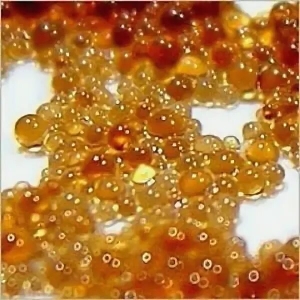Ion Exchange Resins Market Prolific Business Methodology and Techniques, Sales volume and RevenuePosted by Pearl Smith on April 10th, 2023  Ion exchange resins are a type of solid polymer material that can selectively exchange ions with a surrounding solution. They are widely used in various industrial and scientific applications, including water treatment, chemical processing, pharmaceuticals, food and beverage production, and more. Ion exchange resins are typically composed of small beads or particles made of a cross-linked polymer matrix, which provides a porous structure with a large surface area for ion exchange to occur. The polymer matrix is usually functionalized with specific chemical groups that determine the type of ions that can be exchanged. Common functional groups include sulfonic acid (-SO3H) for cation exchange resins that exchange positively charged ions (cations), and quaternary ammonium (-NR4+) for anion exchange resins that exchange negatively charged ions (anions). The ion exchange process occurs when ions in a solution come into contact with the resin beads. The ions that have a higher affinity for the resin's functional groups will replace the ions originally attached to the resin, resulting in an exchange of ions between the resin and the solution. This allows for selective removal or recovery of specific ions from a solution. The global ion exchange resins market is a growing industry that is driven by various factors, including increasing demand for clean water, growing awareness about water pollution and the need for water treatment, and the expanding industrial and manufacturing sectors. The ion exchange resins market is also influenced by factors such as regulatory requirements for water quality, advancements in technology, and increasing applications in diverse industries. The market for ion exchange resins is segmented based on type, application, end-use industry, and geography. The most common types of ion exchange resins include cation exchange resins, anion exchange resins, and mixed bed resins. Cation exchange resins are used for cation exchange processes, anion exchange resins are used for anion exchange processes, and mixed bed resins are used for both cation and anion exchange processes. Ion exchange resins find applications in various industries, including water treatment, chemical processing, pharmaceuticals, food and beverages, power generation, and others. In the water treatment industry, ion exchange resins are used for water softening, demineralization, dealkalization, and removal of heavy metals and other contaminants. In the chemical processing industry, they are used for purification, separation, and recovery of chemicals and compounds. In pharmaceuticals, they are used for drug purification and formulation. In food and beverages, they are used for juice and wine clarification, sugar decolorization, and other applications. In power generation, they are used for water treatment in boilers and condensers to prevent scale formation. Geographically, the ion exchange resins market is segmented into regions such as North America, Europe, Asia-Pacific, Latin America, and Middle East & Africa. Asia-Pacific is expected to be the fastest-growing region due to increasing industrialization, urbanization, and growing awareness about water pollution and the need for water treatment. North America and Europe are also significant markets for ion exchange resins due to strict water quality regulations and increasing demand for clean water. Major players operating in the global ion exchange resins market include The Dow Chemical Company, Lanxess Ag, Purolite Corporation, Thermax Limited, Ion Exchange India Ltd., Samyang Holdings Corporation, Mitsubishi Chemical Holdings Corporation, Sunresin New Materials Co. Ltd., ResinTech Inc., Novasep Holding, Samyang Corporation, Bio-Rad Laboratories Inc. and Jiangsu Suqing Water Treatment Engineering Group Co., Ltd
➢ Water treatment and purification: Ion exchange resins are widely used in water treatment and purification processes to remove contaminants such as dissolved salts, heavy metals, nitrates, and other pollutants from drinking water, industrial process water, and wastewater. These resins are used in both municipal and industrial water treatment plants to improve water quality, meet regulatory standards, and ensure safe and clean water supply. ➢ Chemical processing: Ion exchange resins are used in the chemical industry for various applications, such as purification of process streams, recovery of valuable compounds, and removal of impurities. They are used in processes such as demineralization, decolorization, deionization, and catalysis in chemical reactions, contributing to the production of high-quality chemicals and intermediates. ➢ Pharmaceuticals: Ion exchange resins are used in the pharmaceutical industry for purification of Active Pharmaceutical Ingredients (APIs) and other chemicals, as well as for drug formulation and drug delivery systems. These resins help in removing impurities, such as salts, organic compounds, and heavy metals, from pharmaceutical products to ensure their quality, safety, and efficacy. ➢ Food and beverages: Ion exchange resins are used in the food and beverage industry for water purification, as well as for removal of impurities, such as color, taste, and odor, from process streams. These resins help in improving the quality of drinking water, soft drinks, fruit juices, brewing water, and other food and beverage products. ➢ Power generation: Ion exchange resins are used in the power generation industry for water treatment in steam generation systems, such as boilers and condensers. These resins help in removing impurities from water, such as dissolved salts and heavy metals, to prevent scaling, corrosion, and fouling in the steam generation equipment, which can improve their efficiency and extend their lifespan. ➢ Electronics: Ion exchange resins are used in the electronics industry for purification of ultrapure water used in semiconductor manufacturing processes. These resins help in removing trace impurities from water, such as ions, organic compounds, and particulate matter, which can impact the quality and reliability of electronic devices. ➢ Mining and metallurgy: Ion exchange resins are used in the mining and metallurgy industry for recovery of valuable metals, such as gold, silver, uranium, and rare earth elements, from process streams and waste streams. These resins help in selectively adsorbing and recovering specific metal ions from complex mixtures, providing an efficient and cost-effective method for metal recovery. ➢ Environmental remediation: Ion exchange resins are used in environmental remediation processes for removal of contaminants from soil, groundwater, and other environmental matrices. These resins can selectively adsorb contaminants, such as heavy metals, radioactive ions, and organic pollutants, from environmental media, contributing to the cleanup of contaminated sites and protection of the environment. ➢ Other applications: Ion exchange resins are also used in various other applications, such as sugar refining, biotechnology, cosmetics, and personal care products, where purification, separation, and recovery of specific ions or compounds are required. The ion exchange resins market offers several benefits, which contribute to its growing demand across various industries. Some of the key benefits of ion exchange resins are: ✦ Water purification In summary, the benefits of ion exchange resins include water purification, selective ion removal, process efficiency, wide range of applications, compliance with environmental regulations, improved product quality, and cost-effective solutions, which contribute to their growing demand in the market. Like it? Share it!More by this author |


